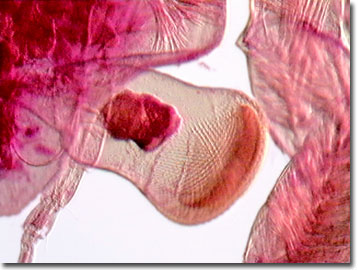Oblique Digital Image Gallery
Crab Megalops Life Stage
As with other members of the phylum Arthropoda, crab species in the class Crustacea must undergo metamorphosis as they grow and mature because of the their hard exoskeletons. For most species, except for a few freshwater varieties, newly hatched crabs bear little resemblance to their parents. From the egg to mature adult life stage, the crab must undergo several transformations before displaying typical adult characteristics.

In the early larval or zoea stage, the crab begins life as a transparent, microscopic member of the zooplankton community, cast to the whims and mercy of the prevailing currents and tides. As the zoea grows, it molts repeatedly while approaching the second larval or megalops life stage. The young crab or megalops abandons its rounder, legless body shape for one more closely resembling an adult crab equipped with little claws and other legs.
Bearing a close appearance to some of the tailed members of the order Decapoda (lobsters, crayfish, shrimp), the megalops appears to have a tail because it has not curled and tucked under its large abdomen. Megalops crab larva swim and crawl along the substrate as they feeds and grow into adulthood. After further molting, the megalops emerges into the first crab stage as a smaller version of its parents.
Contributing Authors
Cynthia D. Kelly, Thomas J. Fellers and Michael W. Davidson - National High Magnetic Field Laboratory, 1800 East Paul Dirac Dr., The Florida State University, Tallahassee, Florida, 32310.
BACK TO THE OBLIQUE IMAGE GALLERY
BACK TO THE DIGITAL IMAGE GALLERIES
Questions or comments? Send us an email.
© 1995-2025 by Michael W. Davidson and The Florida State University. All Rights Reserved. No images, graphics, software, scripts, or applets may be reproduced or used in any manner without permission from the copyright holders. Use of this website means you agree to all of the Legal Terms and Conditions set forth by the owners.
This website is maintained by our
Graphics & Web Programming Team
in collaboration with Optical Microscopy at the
National High Magnetic Field Laboratory.
Last Modification Friday, Nov 13, 2015 at 01:19 PM
Access Count Since September 17, 2002: 19612
Visit the website of our partner in introductory microscopy education:
|
|
